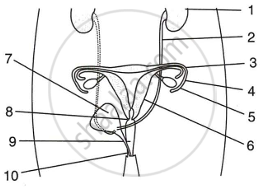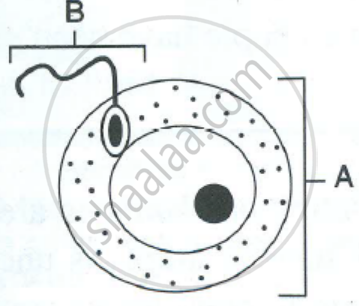Advertisements
Advertisements
Question
What are the different methods of contraception?
Solution
The contraceptive methods can be broadly divided into the following types:
- Natural method: It involves avoiding the chances of meeting sperm and ovum. In this method, the sexual act is avoided from day 10th to 17th of the menstrual cycle because during this period, ovulation is expected and therefore, the chances of fertilization are very high.
- Barrier method: In this method, the fertilization of ovum and sperm is prevented with the help of barriers. Barriers are available for both males and females. Condoms are barriers made of thin rubber that are used to cover penis in males and vagina in females.
- Oral contraceptives: In this method, tablets or drugs are taken orally. These contain small doses of hormones that prevent the release of eggs and thus fertilization cannot occur.
- Implants and surgical methods: Contraceptive devices such as the loop or Copper-T are placed in uterus to prevent pregnancy. Some surgical methods can also be used to block the gamete transfer. It includes the blocking of vas deferens to prevent the transfer of sperm, known as vasectomy. Similarly, the fallopian tubes of the female can be blocked so that the egg will not reach the uterus, known as tubectomy.
RELATED QUESTIONS
What are the functions of testes in the human male reproductive system?
Why are testes located outside the abdominal cavity? What is responsible for bringing about changes in appearance seen in boys at the time of puberty?
State whether human beings reproduce by sexual method or asexual method.
What do the ovaries in a woman produce?
What is gestation period? How much is the gestation period in humans?
What is placenta? What is its function?
The male gametes in a flower and in a human are produced respectively in :
(a) stigma and ovary
(b) anther and style
(c) ovary and testes
(d) anther and testes
When a human female reaches a certain age then vaginal bleeding occurs for a few days after regular time intervals.
(a) What is this process known as (i) in scientific terms, and (ii) in everyday language?
(b) At what approximate age this process starts in human females? When is the human female said to have attained at this stage?
(c) After how much time is this process repeated? For how many days does this process usually last?
(d) What does the onset of this process in human females signify?
(e) At which particular event in the life of a human female does this process stop temporarily but start again?
(f) At which approximate age of human female does this process stop permanently?
When a female child is born, her ovaries already contain thousands of immature eggs (or ova) contained in immature structures A. On maturing, A bursts open and an egg shoots out of the ovary in a process called B. The process B starts in the females at puberty and occurs again and again after a time period x. Before every occurrence of process B, the inner lining of uterus becomes thick and soft with lots of blood vessels in it. When the egg cell gets fertilised by a sperm, then an event C occurs in the life of mature human female which lasts for time period y leading to the birth of baby. If, however, the egg cell released by the ovary does not get a sperm to fuse with, then the thick and soft inner lining of uterus breaks down and comes out of the female's body in an event called D. The occurrence of event D is controlled by chemical substances E.
(a) What are A?
(b) What is process B?
(c) What is the time period x?
(d) Name the event C.
(e) How much is the time period y?
(f) What is the name of process D?
(g) Name the chemical substances E.
Given below is a diagram of two systems together in the human body.
 |
- Name the systems.
- Name the parts numbered 1-10.
- Describe the functions of the parts 3, 4, 5 & 6.
- What will happen if the part 3 on both sides gets blocked?
The diagram below represents two reproductive cells A and B. Study the same and then answer the questions that follow:
 |
- Identify the reproductive cells A and B.
- Name the specific part of the reproductive system where the above cells are produced.
- Where in the female reproductive system do these cells unite?
- Name the main hormones secreted by the (1) ovary (2) testes.
- Name an accessory gland found in the male reproductive system and state the function of its secretion.
List two changes observed in girls at the time of puberty.
State the role of placenta in the development of embryo.
Give appropriate term of the following:
The onset of reproductive phase in a young female.
Differentiate
Urinogenital system and Urinary system.
Explain the term Parturition or birth.
Choose the Odd One Out:
Mention the importance of the position of the testes in humans.
______ is a lytic enzyme released by the sperm.
How does human sperm locomote?
